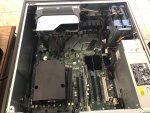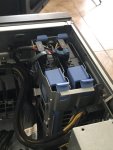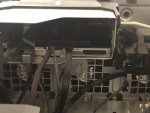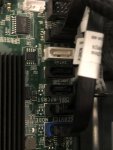p_funk_era
Cadet
- Joined
- Sep 9, 2020
- Messages
- 2
The current FreeNAS Server I put together is to be used for local image based (Processed by Veeam Backup and Recovery on a separate machine) backup storage for the One Physical Windows Server. It will then be replicated to the Backblaze B2 Cloud, and then to a third backup repository on the parent company's backup infrastructure.
I installed FreeNAS 11.3-U41 on a Dell Precision T3600 Xeon Workstation, and was hoping someone could advise me on how best to allocate my storage setup for the hardware I'm currently working with.
Here are the Specs on the Dell T3600 Workstation:
Stock Intel C600 Chipset/Motherboard
Xeon E5-1607 CPU
8GB DDR3 Non ECC Ram
Installed FreeNAS 11.3 U41 OS in a (2) drive mirror to:
(2) New 32GB SanDisk Ultra USB Flash Drives
My HDD/SSD Storage Hardware consists of:
(2) New 4TB Seagate IronWolf NAS Internal Hard Drives HDD – CMR 3.5 Inch SATA 6Gb/s 5900 RPM 64MB Cache attached to HDD0 and HDD2 Onboard SAS Ports
(1) Used-Very Good 480GB SanDisk SATA SSD attached to a Onboard Sata Port
(1) Used-Very Good 250GB Samsung Evo 970 NVME PCIe M.2 SSD attached to the PCIe X16 Slot
Any advice on possible storage device allocations and or OS configuration for what I'm working with is greatly appreciated.
TIA
FreeNAS 11.3-U4 on Dell T3600 Workstation:
Intel C600 Chipset/Stock Motherboard
Xeon E5-1607 CPU
8GB DDR3 1600 MHz Ram
2 - 32GB Sandisk Ultra USB Flash Drives for OS
2 - 4TB Seagate IronWolf NAS CMR HDDs 5900RPM 64MB Cache??
1 - 480GB Sandisk SATA SSD Plus??
1 - 250GB Samsung Evo 970 NVME M.2 PCIe SSD??
I installed FreeNAS 11.3-U41 on a Dell Precision T3600 Xeon Workstation, and was hoping someone could advise me on how best to allocate my storage setup for the hardware I'm currently working with.
Here are the Specs on the Dell T3600 Workstation:
Stock Intel C600 Chipset/Motherboard
Xeon E5-1607 CPU
8GB DDR3 Non ECC Ram
Installed FreeNAS 11.3 U41 OS in a (2) drive mirror to:
(2) New 32GB SanDisk Ultra USB Flash Drives
My HDD/SSD Storage Hardware consists of:
(2) New 4TB Seagate IronWolf NAS Internal Hard Drives HDD – CMR 3.5 Inch SATA 6Gb/s 5900 RPM 64MB Cache attached to HDD0 and HDD2 Onboard SAS Ports
(1) Used-Very Good 480GB SanDisk SATA SSD attached to a Onboard Sata Port
(1) Used-Very Good 250GB Samsung Evo 970 NVME PCIe M.2 SSD attached to the PCIe X16 Slot
Any advice on possible storage device allocations and or OS configuration for what I'm working with is greatly appreciated.
TIA
FreeNAS 11.3-U4 on Dell T3600 Workstation:
Intel C600 Chipset/Stock Motherboard
Xeon E5-1607 CPU
8GB DDR3 1600 MHz Ram
2 - 32GB Sandisk Ultra USB Flash Drives for OS
2 - 4TB Seagate IronWolf NAS CMR HDDs 5900RPM 64MB Cache??
1 - 480GB Sandisk SATA SSD Plus??
1 - 250GB Samsung Evo 970 NVME M.2 PCIe SSD??




